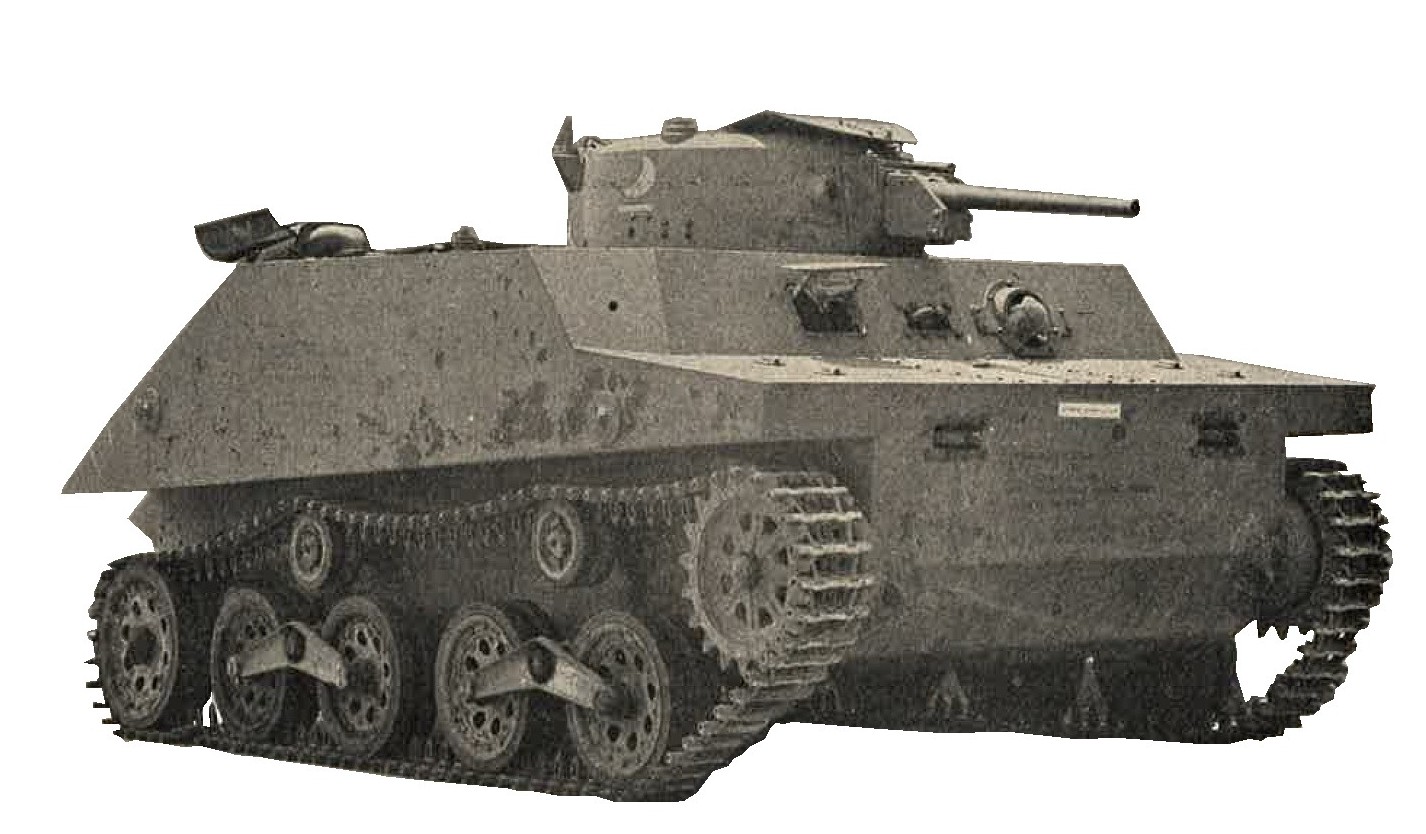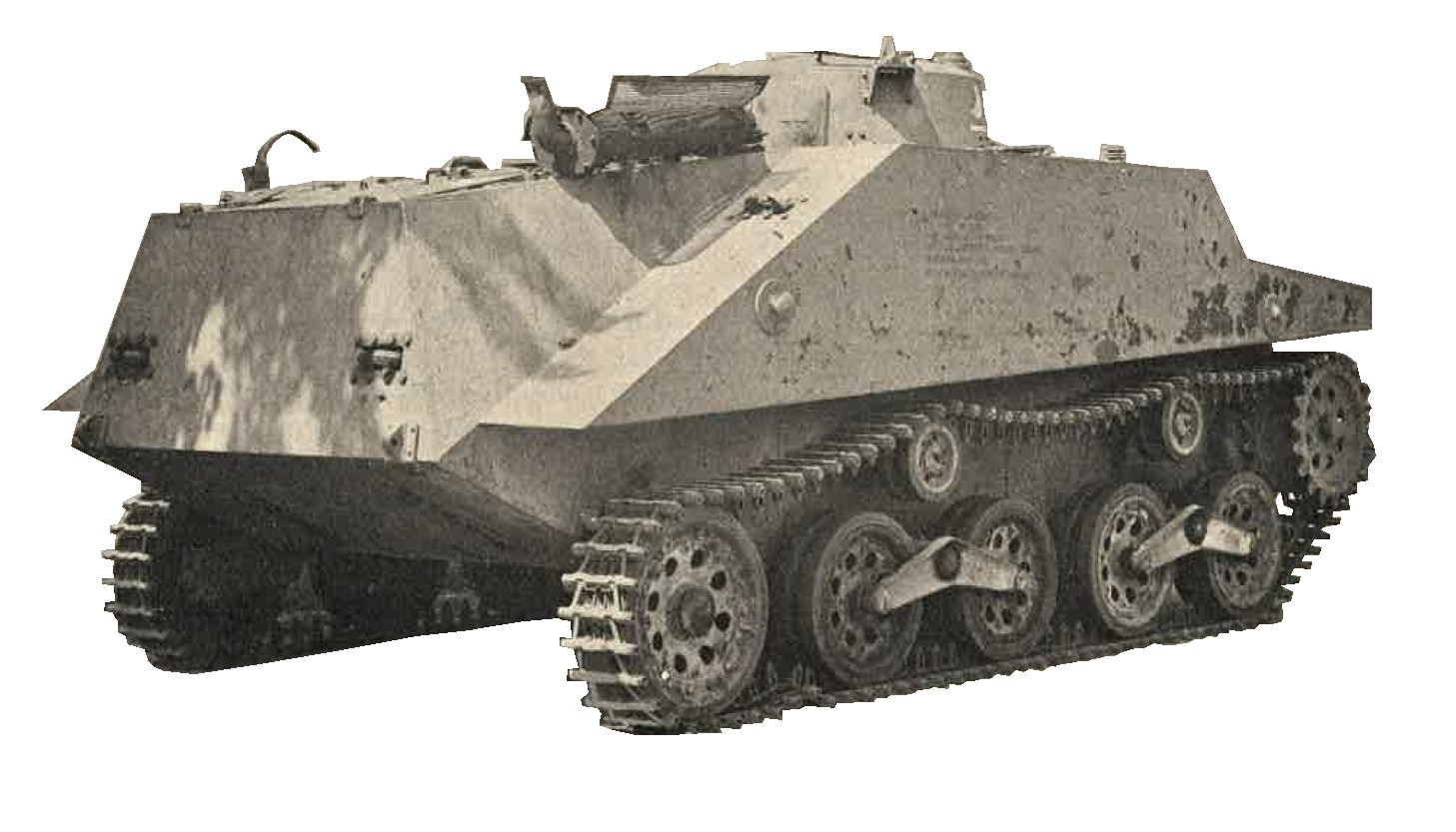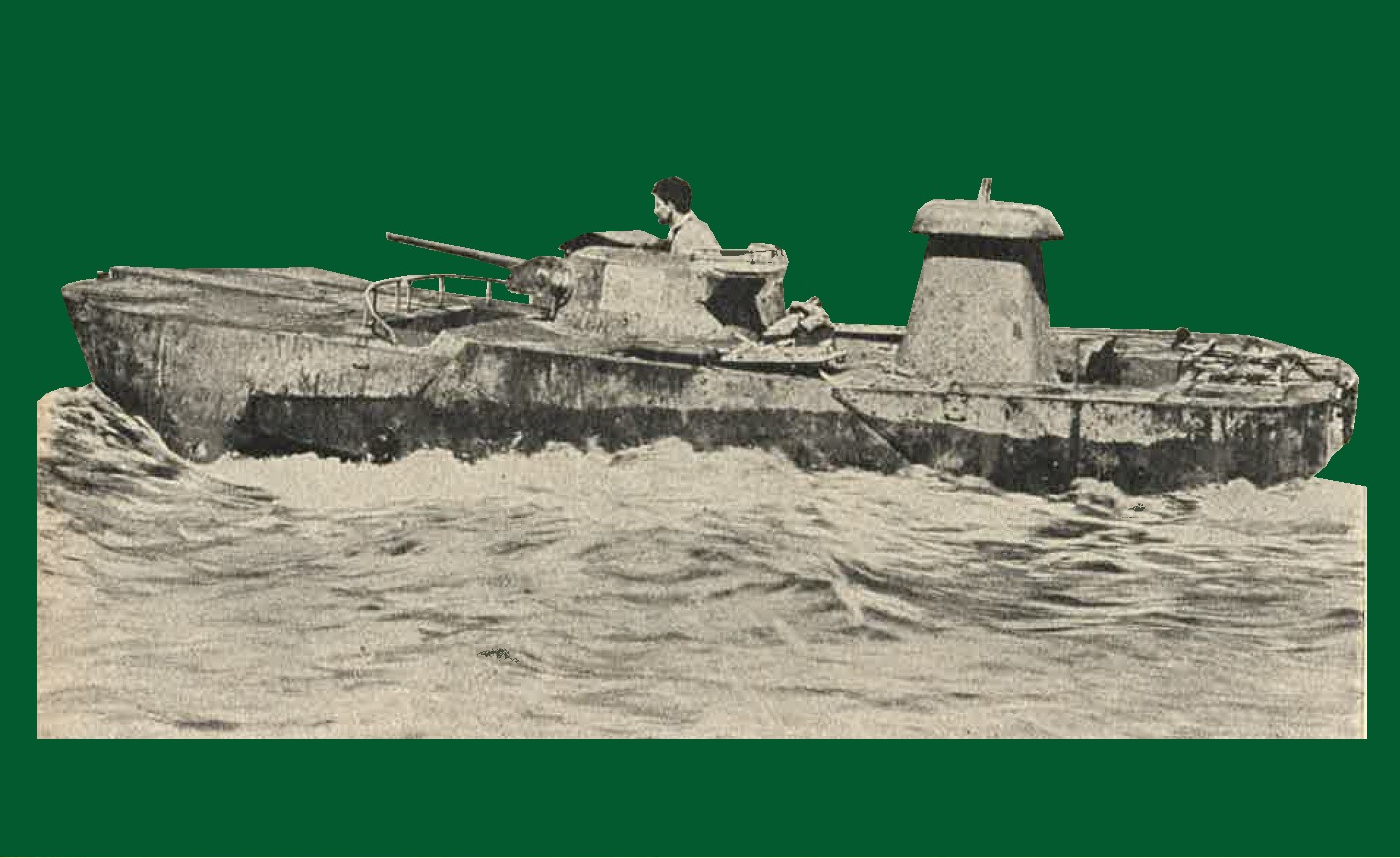CHAPTER 9-C2 TANKS AND TANKETTES

6. WWII JAPANESE AMPHIBUOUS TANKS.
a. General.
The development of Japanese amphibious tanks is similar to that of their ground tanks. The first amphibian was purchased from a foreign country, and provided the initial impetus for Japanese experiments. A specific instance of this is the "Vickers amphibious light tank". Several modifications of the Vickers are believed to have been produced by the Japanese.
b. Type 94 (1934) light amphibuous tank.
An unconfirmed report indicates the existance of a tank, tentatively identified as the Type 94 (1934) light amphibious tank, although it has not been encountered to date (1944).
Approximate specifications:
| Weight | ------------ | 4 Tons. |
| Length | ------------ | 14 feet 10 inches. |
| Width | ------------ | 7 feet 11 inches. |
| Height | ------------ | 8 feet 10 inches. |
| Armament | ------------ | 1 - 37-mm gun, 1 Machine Gun. |
| Armor | ------------ | Up to 20-mm (0.79 inch). |
It is considered that the armor and armament, coupled with the dimensions, are hardly compatible with a weight of only 4 tons.
c. Type 2 (1942) amphibious tank.
The Type 2 amphibious tank is a full-tracked amphibious vehicle for use in beachhead and land operations. The crew of five men includes a commander, a gunner, driver, hull machine gunner, and engineer.
The turret is constructed of rolled armor plate with an all-around thickness of 0.52 inch. The turret hatch armor is 0.24 inch thick and is also constructed of rolled armor plate.
The hull is constructed of rolled armor plate which is bolted and riveted together. The tank hull is not compartmented, and the engineer has working space completely around the engine except where the mounting is attached to the back of the hull. All openings up to and including the turret ring are sealed with rubber.
The engine, located in the rear of the vehicle, is a six cylinder, air cooled Diesel. It drives the transmission through a transfer case arranged with two propelling shafts extending to the rear, one on each side of the engine. Engagement for water travel is made from a handle on the transfer case for each propeller. The transfer case also contains a built-in bilge pump for discharging hull leakage.
There is ample storage space for machine gun ammunition. The exact number of rounds carried is not known, although it is probably 3,500 to 3,900 rounds/ The hull machine gun is mounted in a cast armor plate ball mount, with 35 degrees free traverse in any direction. The cast plate in this ball mount is one of the two places where rolled armor plate is not used; the other is the turret gun manlet which is also cast. Mounting the second machine gun coaxially with the 37-mm gun us an innovation in Japanese tanks.
Weight distribution
|
Weapons
|
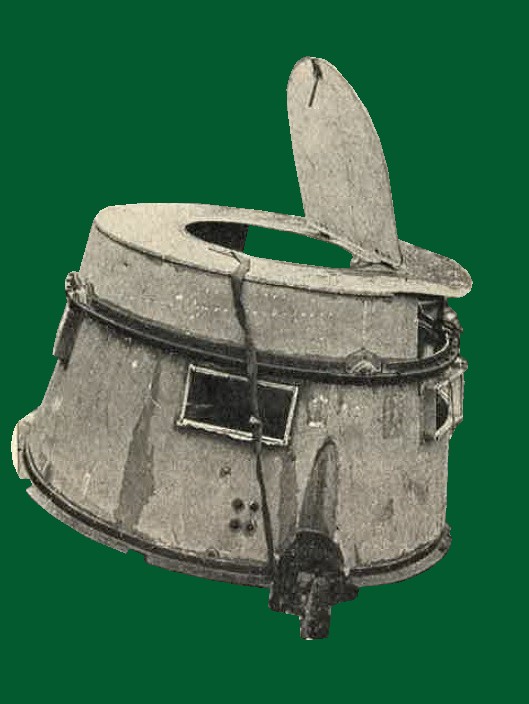
Figure 348. Spray guard fitted on the turret of the Type 2 (1942) amphibious tank. This photo shows the right side of the spray guard with hatch open. |
Armor:
|
Engine and power plant:
|
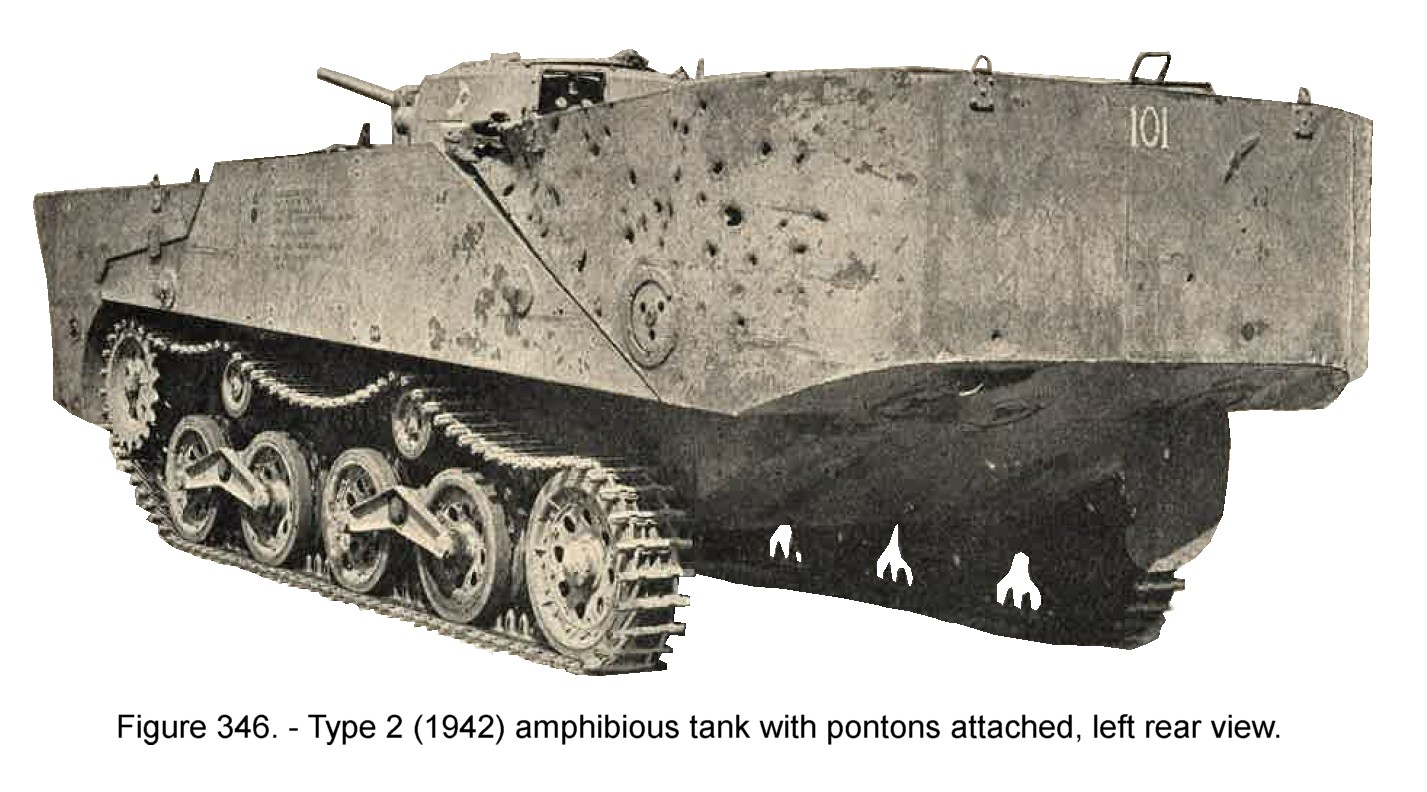 |
Drive:
|
Escape hatches:
|
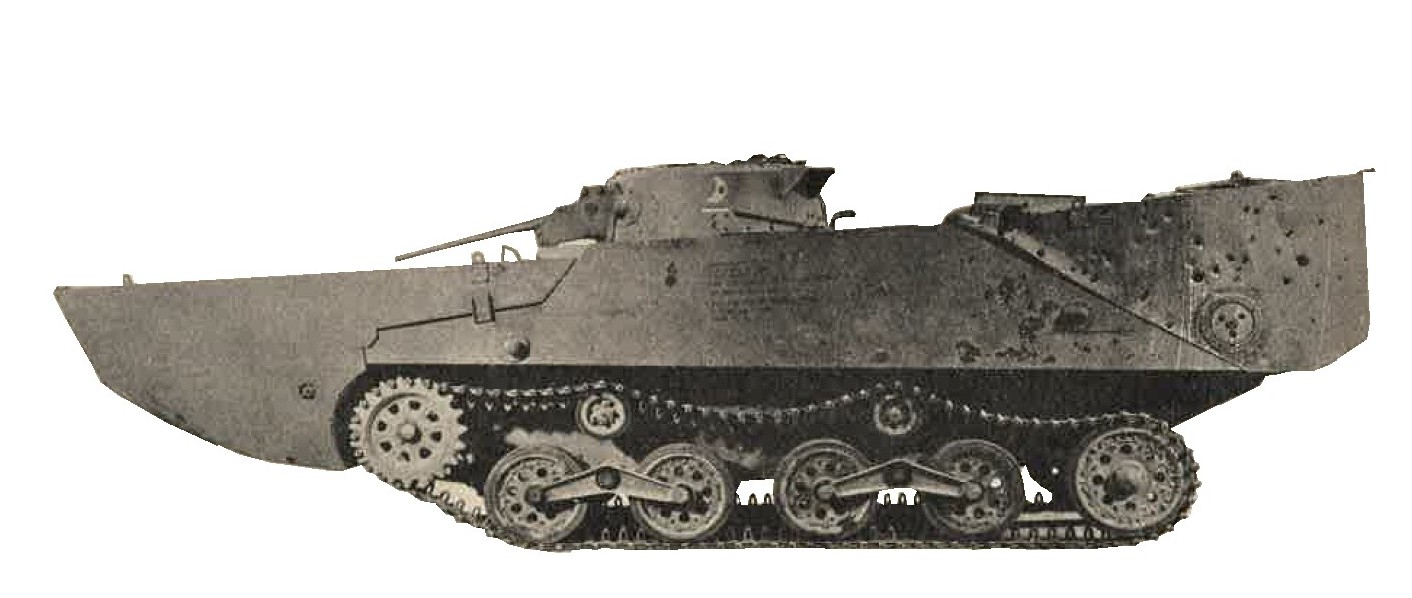
Figure 344. Type 2 (1942) amphibious tank with pontons attached, but no engine air duct or turret guard.
Pistol Ports:
|
Vision:
|
Tracks:
|
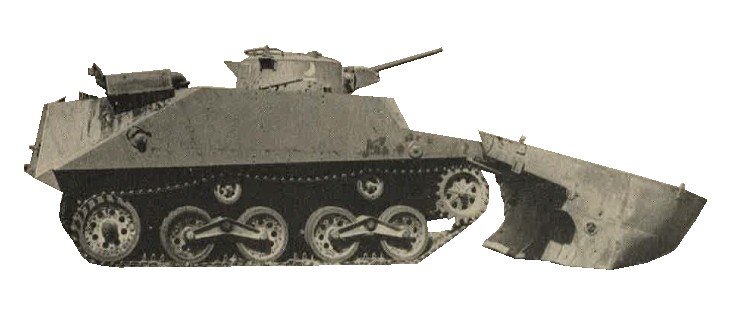
Figure 250. New type amphibious tank. |
Steering:
| 1. | On land | --------- | Clutch brake. |
| 2. | In water | --------- | Rudder and propeller. |
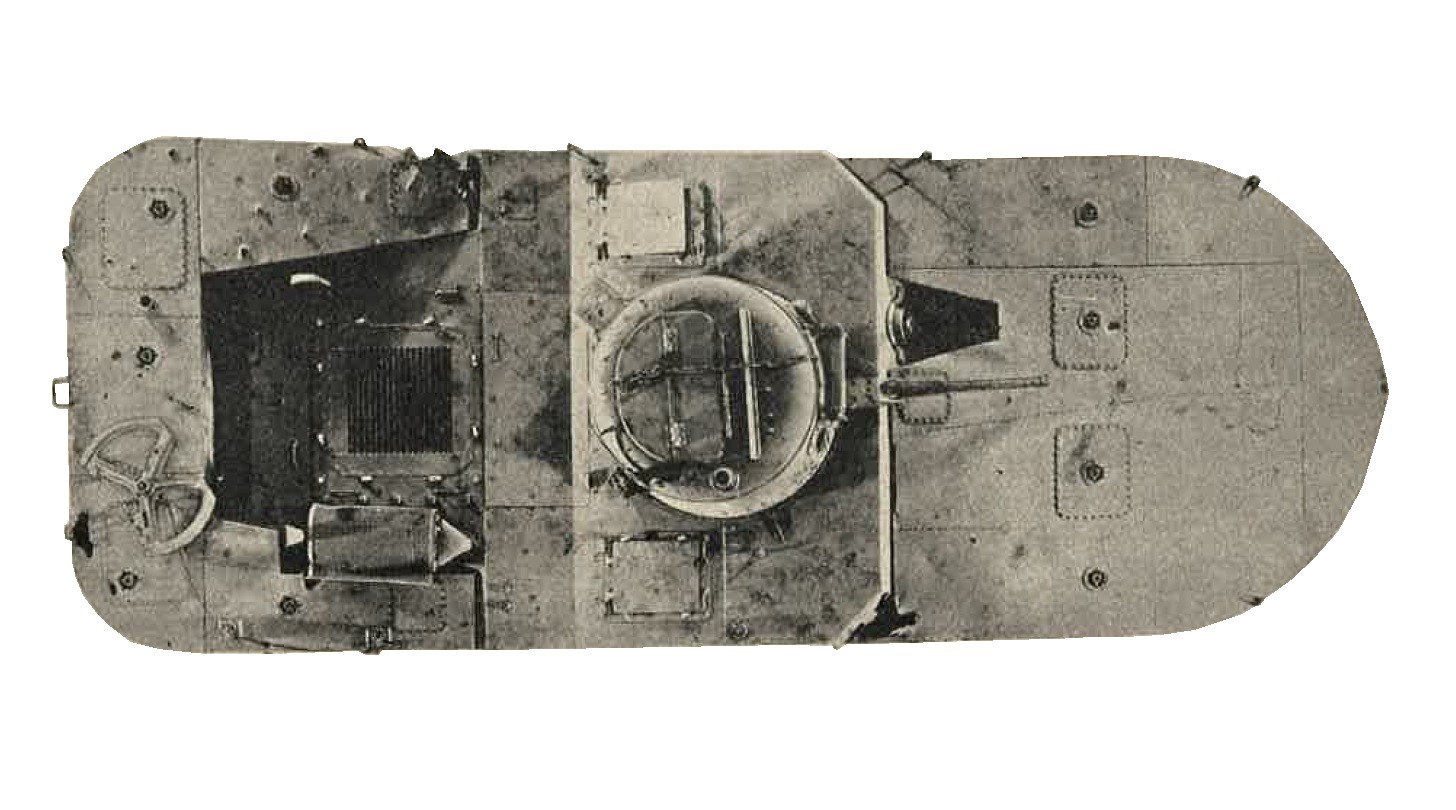
Figure 347. Type 2 (1942) amphibious tank with pontons attached, top view, without air duct or spray guard. 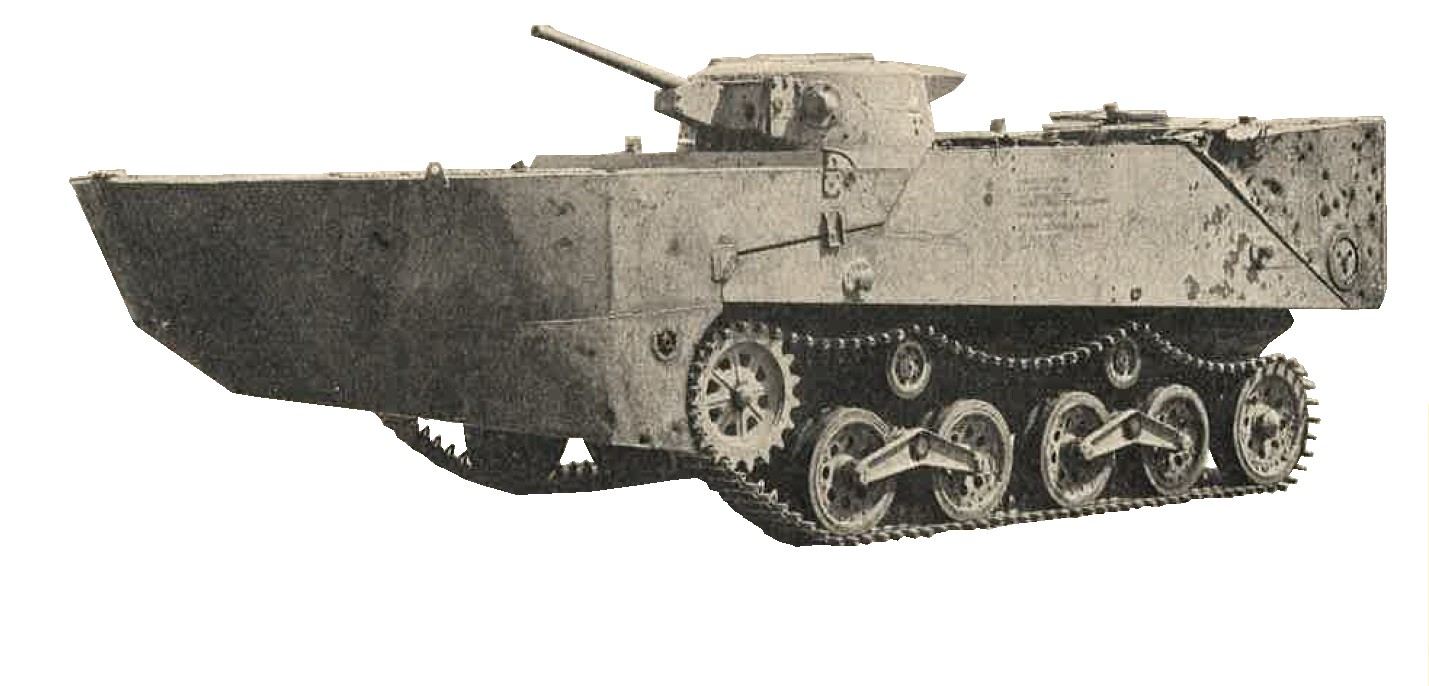
Figure 345. Type 2 (1942) amphibious tank with pontons attached, left front view. |
General suspension specifications:
|

7. WWII JAPANESE ARMORED CARS.
a. Japanese Armored car Model 25 (?) "Vickers Crossley".
This armored car (Figure 251) may be classified as obsolete and is readily identified by it hemispherical turret. A small domed cupula, in two hinged halves, surmounts the turret. Traverse 360 degrees, the turret mounts only two machine guns, although there is provision for four. Each of the weapon openings is covered with a small flap, which is closed when the gun is removed. All machine guns are of the Vickers type. Guns are ball mounted and have a limited traverse independant of the turret. The front wheels are single, while the rear wheels are dual. The chasis is believed to be standard commercial type weighing 2.8 tons. In the past, this armored car was incorrectly classified as the "OSAKA" Type 92 (1932).
APPROXIMATE SPECIFICATIONS
|
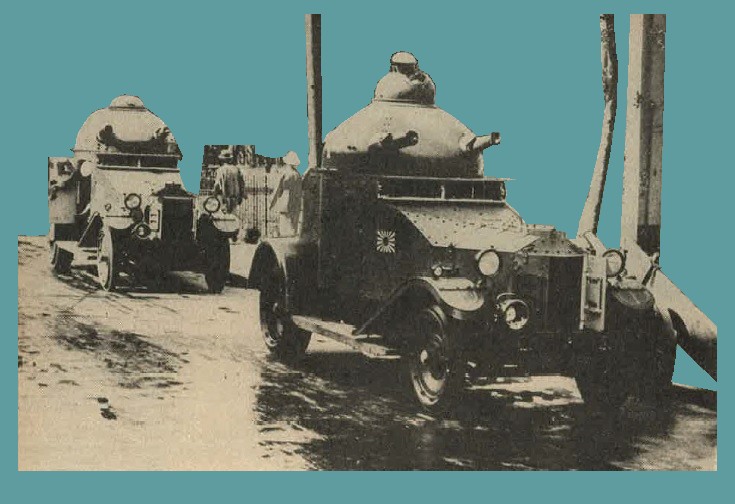
Figure 251. Model 25 Vickers Crossley car. |
b. Japanese Armored car Model 92 (1932) naval type.
This vehicle was likely produced in 1942. The insignia indicates that it (figure 252) is a naval vehicle. In addition to the machine gun in the front and rear, one is mounted on each side of the hull. One is also mounted in the turret. Semielliptic springs provide the suspension for the 6 disc wheel chassis. Wheels are fitted with pneumatic tires. To prevent bellying, when crossing rough terrain, auxiliary wheels are mounted on the frame to the rear of the front wheels.
The radiator is provided with armored shutters. Reconnaissance and guard duties constitute the chief role for this vehicle.
APPROXIMATE SPECIFICATIONS
|
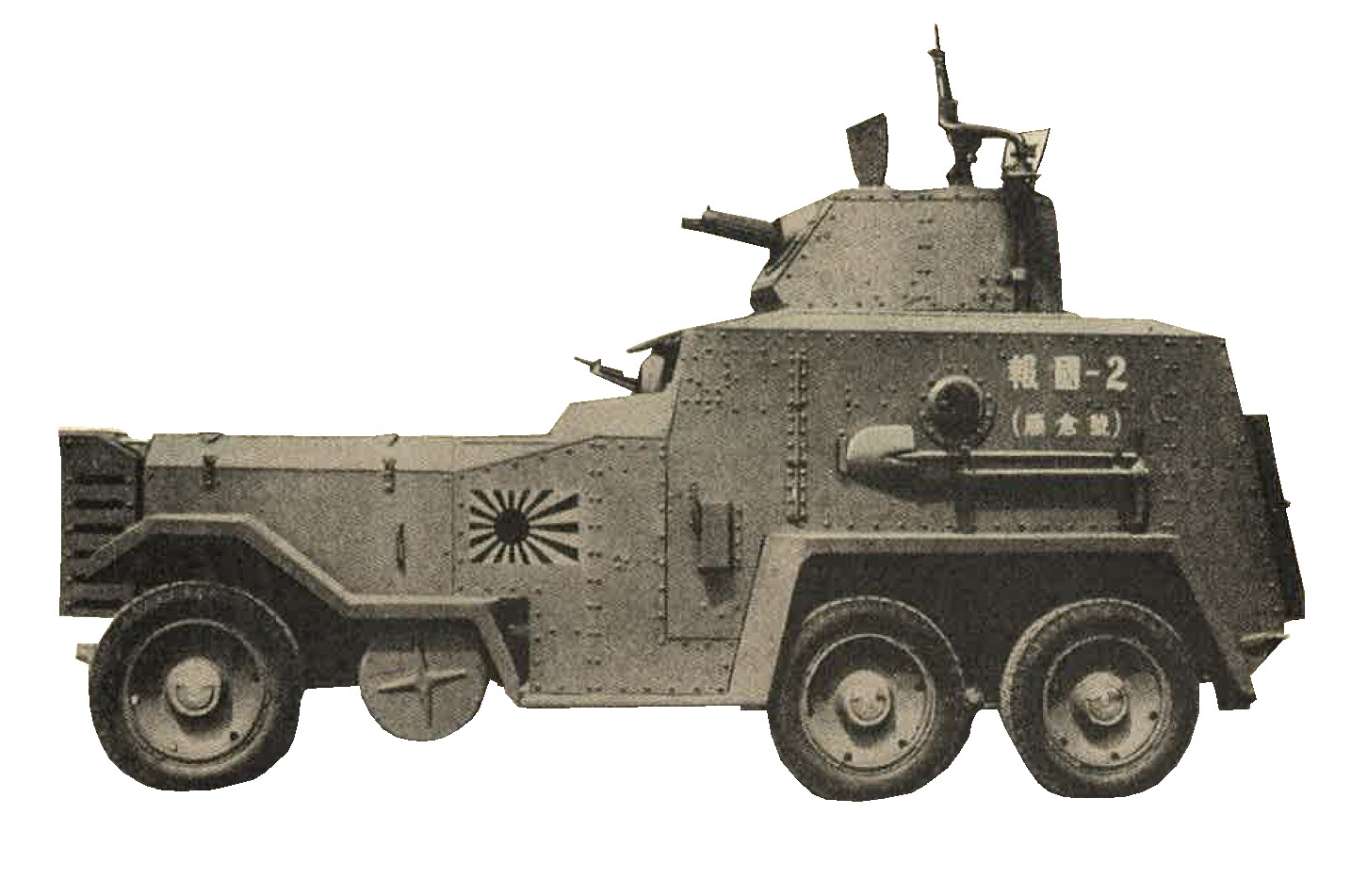
Figure 252. Model 92 Naval armored car. |
APPROXIMATE MAXIMUM PERFORMANCE
| Speed | ---------- | 50 miles per hour |
| Range of action | ---------- | 100 to 150 miles |
c. Japanese Armored car Model 92 (1932) "OSAKA".
Until recently (1944), considerable confusio has existed between this armored car and the model 25(?) "Vickers Crossley", specifications of the "Osaka" being attributed to the later vehicle. While no details are available, it is believed that the "Osaka" is of Japanese origin, a standard commercial chassis being used for its manufacture. Wheels are fitted with pneumatic tires. The front single and the rear dual mounted. Machine guns are of the Vickers type; One is mounted in the front of the turret.As an extensive free traverse has been allowed to this gun, it is considered possible that the turret is fixed and cannot be traversed. As the design of the driver's front plate gives no indication that the second machine gun is mounted in the front of the hull, it is probable that this weapon is mounted at the rear of the vehicle.
APPROXIMATE SPECIFICATIONS
| Weight | ---------- | 6.4 ton. |
| Length | ---------- | 10 feet, 5 inches |
| Width | ---------- | 6 feet |
| Height | ---------- | 8 feet 8 inches |
| Belly clearance | ---------- | 11 inches |
| Crew | ---------- | 4 to 5 men |
| Armament | ---------- | 2 Machine guns |
| Armor | ---------- | 8 to 11 mm (0.32 to 0.43 inches) |
| Engine | ---------- | 4 cylinders, 35 horse power. |
| Fuel | ---------- | Gasoline. |
| Cooling | ---------- | Water |
APPROXIMATE MAXIMUM PERFORMANCE
|
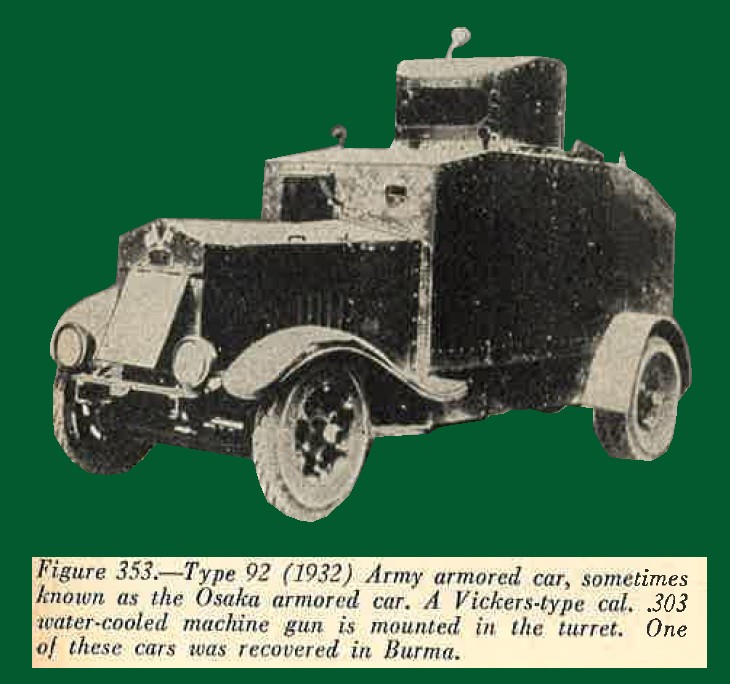
Figure 353. Type 92 (1932) Army armored car, sometimes kown as the Osaka armored car. A Vickers-type cal. .303 water cooled machine gun is mounted in the turret. One of these cars was recovered in Burma. |
d. Japanese Armored car Model 1933 (Sumida).
This vehicle (figure 253) has been used extensively in China and was specially designed to run either on railway lines or hard roads. To effect the change from rails to road, the vehicle is raised up by 4 built in jacks. solid rubber tires then are placed over the 6 flanged steel wheels, and the vehicle can be driven off the rails onto the road. This operation is said to take 10 minutes. When traveling on rails, 3 solid rubber tires are attached on each side of the hull.
APPROXIMATE SPECIFICATIONS
|
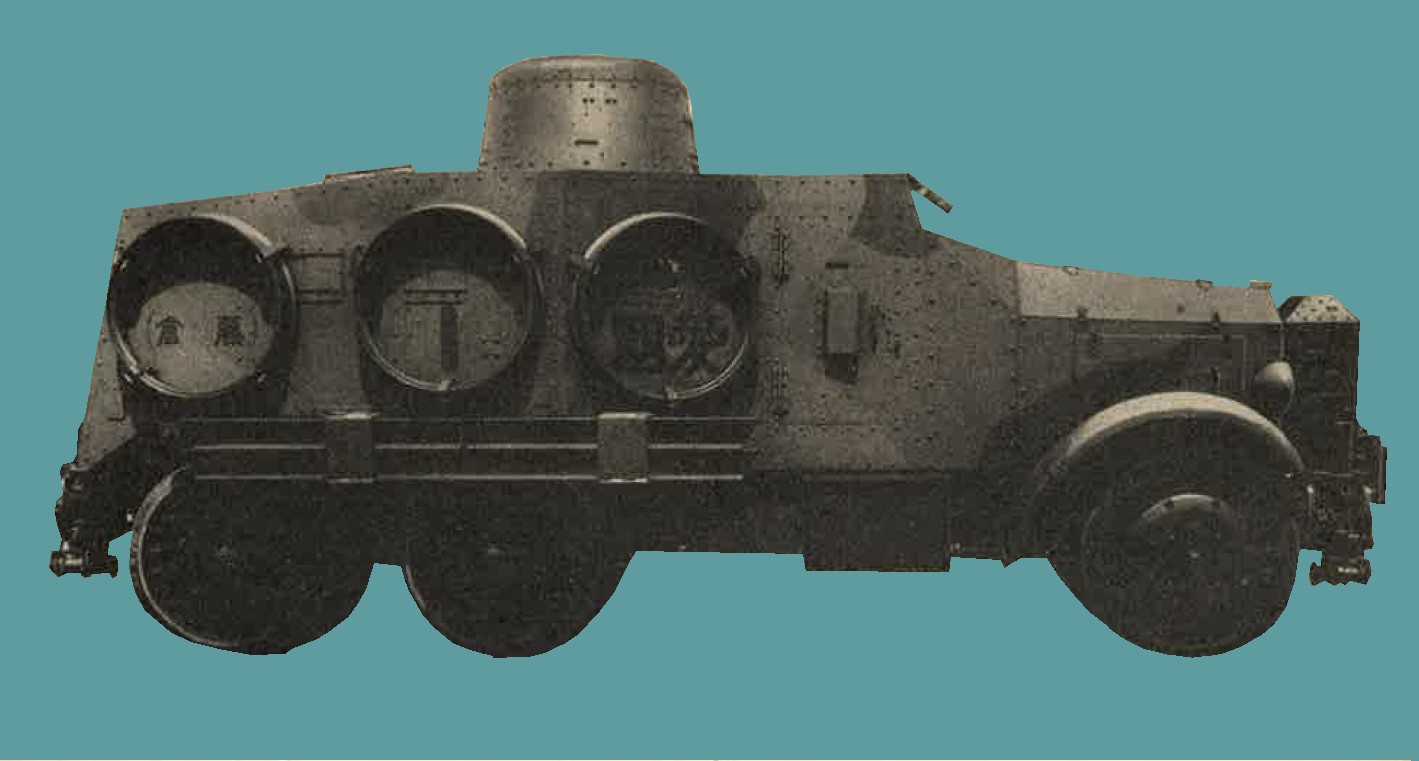
Figure 253. Model 93 Sumida armored car. |
APPROXIMATE MAXIMUM PERFORMANCE
| Speed on rails | ---------- | 37 miles per hour. |
| Speed on road | ---------- | 25 miles per hour. |
e. Miscellaneous types of armored cars.
Recent recoveries in the field have brought to light several types of improvised armored cars. These vehicles were merely Ford and Chevrolet commercial chassis with a wooden frame over which the Japanese had fastened some metal plate. In one case cement was used. It may be expected that some other types of armored cars will be recovered, notably any which might have been captured from the Netherlands East Indies army.

8. WWII JAPANESE SELF PROPELLED GUNS.
a. Japanese self-propelled 15-cm howitzer.
This weapon is the Type 38 (1905) 15-cm howitzer mounted on a medium tank chassis. The tank chassis has not been identified definetely as the Type 97 (1937) medium tank or the Type 97 (1937) medium tank improved, but the width of track (13 inches) would indicate that it is the latter.
|
The armor is assembled by riveting in the characteristic Japanese fashion. The armor on the chassis is the same
as for the tank, with a maximum armor thickness of approximately 1 inch. The gun shield has 1 - inch frontal
armor and 1/2 inch side armor.
There is also an armored shield on top of the side gun shields, but hits shield does not appear to extend far enough to the rear to provide protection for personnel operating the howitzer. The vehicle uses the standard tank V-12, air cooled, Diesel engine, and the Type 97 medium tank suspension. |
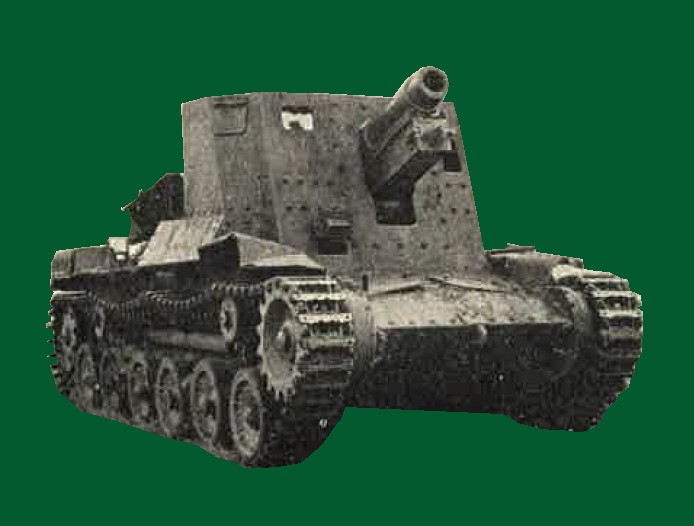
Figure 355. Self propelled 15-cm Howitzer, front. |
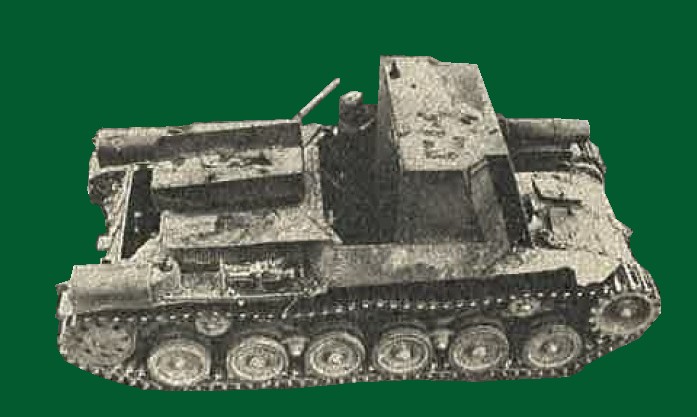
Figure 357. Self propelled 15-cm howitzer, top view. |
|
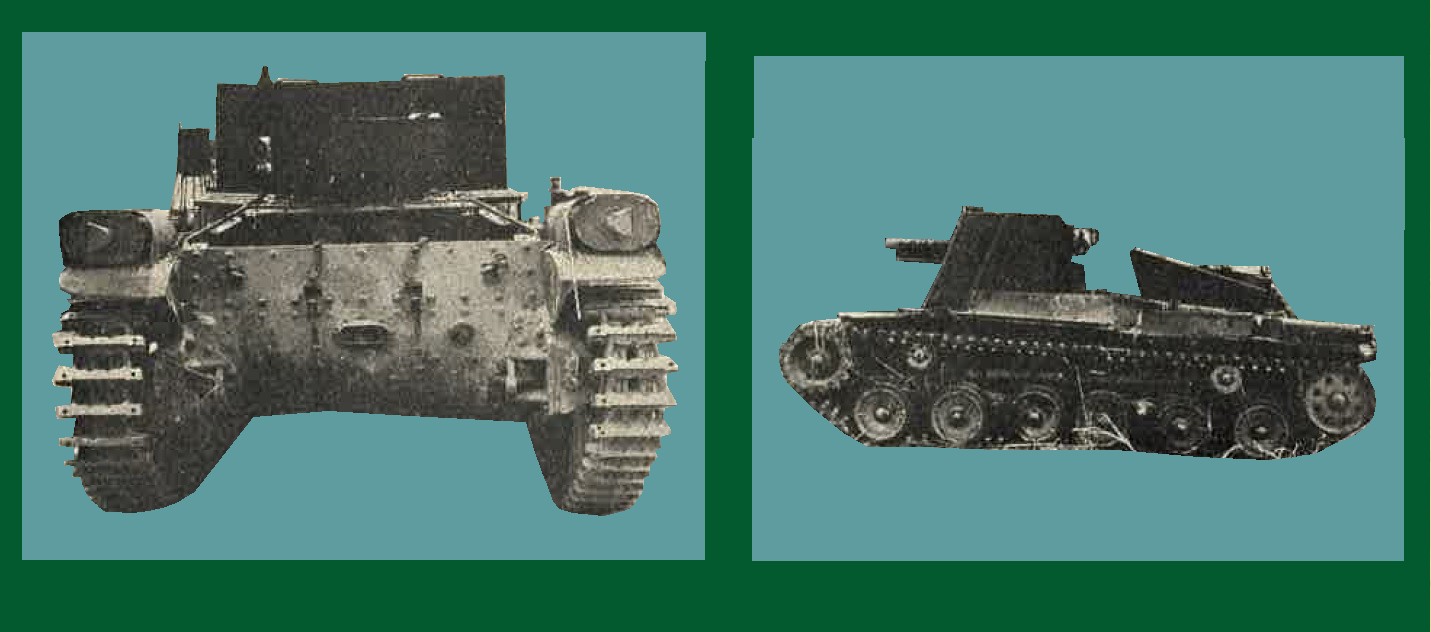
Figure 356. (Left) - WWII Japanese self propelled artillery, front view.
Figure 358. (Right) - WWII Japanese self propelled artillery, side view.
b. Japanese Type 2 (1942) 75-mm self-propelled gun.
This Japanese 75-mm self-propelled gun consists of the tube of the Type 90 (1930) 75-mm field gun mounted on the chassis of the Type 97 (1937) improved medium tank. The chassis remains unchanged, buth the tank turret has been replaced by a built-up superstructure which is open at the top and rear.
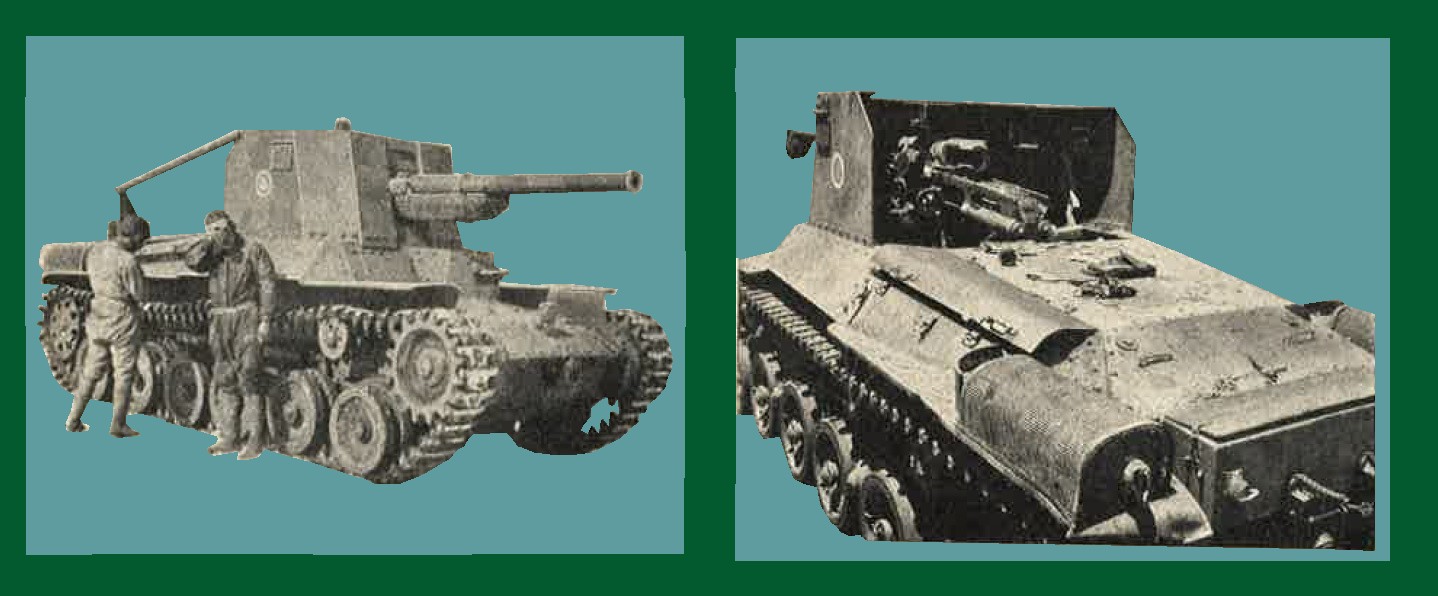
Figure 359. (Left) - Type 2 (1942) 75-mm self propelled gun. Side view.
Figure 360. (Right) - WWII Japanese Type 2 (1942) 75-mm self propelled gun. Rear view.
With the exception of the muzzle ring in place of the muzzle brake and a slightly smaller breech ring. The gun tube is identical to that of the wheeled gun. An internal gun mantlet is fitted and the recoil mechanism is propelled at the front by an armored jacket.
Mounted on a pintle, which is bolted to the floor of the fighting compartment, the gun has a total traverse of 20 degrees and elevated from -5 degrees to +25 degrees. Two range drums mounted on the left of the gun are calibrated to range of 13,000 yards and 8,750 yards. The muzzle velocity is estimated as being 2,230 feet per second, and since the weapon fires the same ammunition as the field piece, it is believed that its armor penetration performance is approximately the same, i.e. 3.5 inches at 500 yards.
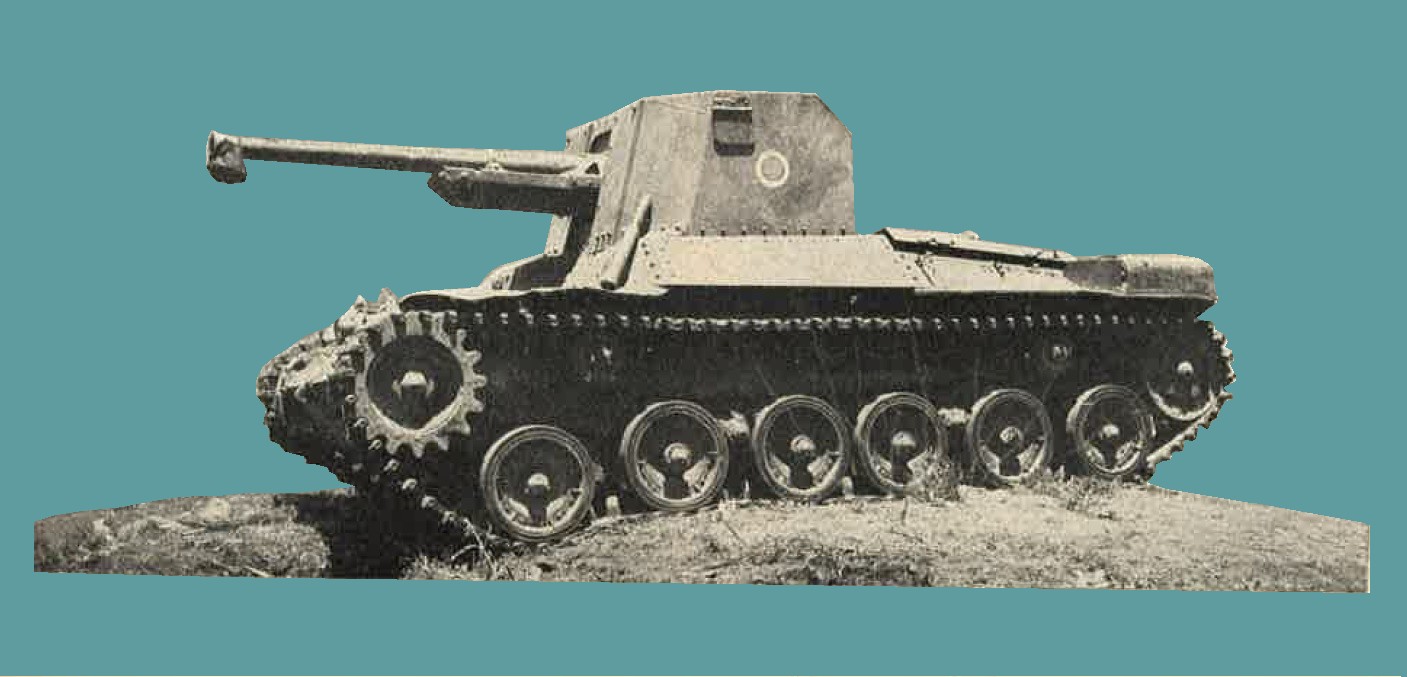
Figure 361. Type 2 (1942) 75-mm self propelled gun. A torn muzzle cover is hanging from the end of the tube.

9. WWII JAPANESE FLAME-THROWING TANKS.
a. Flame throwing tanks captured on Luzon.
Eight Japanese flame-throwing tanks were captured in the Cagayan valley, but their correct nomenclature is not yet determined. although basically similar, they fall into two distinct sub-types, one having external, and the other internal fuel tanks.
|
Both versions of the vehicle have flat tops broken only by a cupola at thye forward end. The suspension is unlike
any previously encountered on any Japanese tank.
There are eight bogie wheels on either side, supported in pairs on bogies whihch are in turn carried on either end of leaf springs. There is a rear drive sprocket, a front idler, and three return rollers (but only two return rollers on the internal fuel tank vehicle). On some of the vehicles large fork like attachments were mounted in front, and it surmised that theese may be intended for clearing mines or obstacles. |
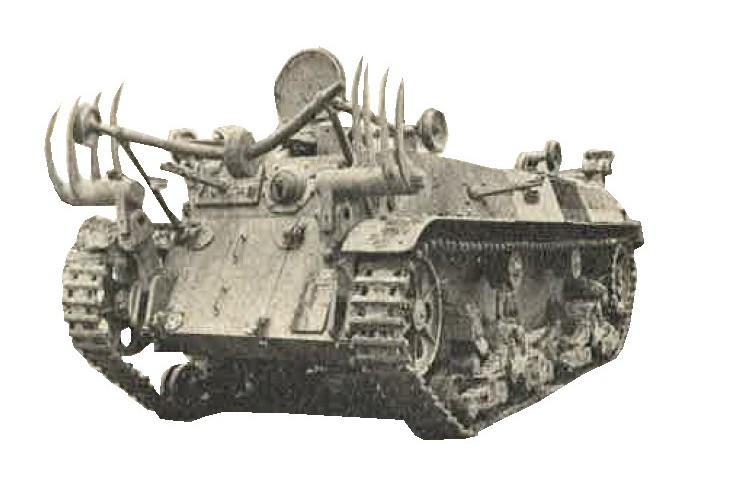
Figure 363. Flame throwing tank with internal fuel tanks, left front view with forks in raised position. |
Armor specifications:
|
Specifications:
|
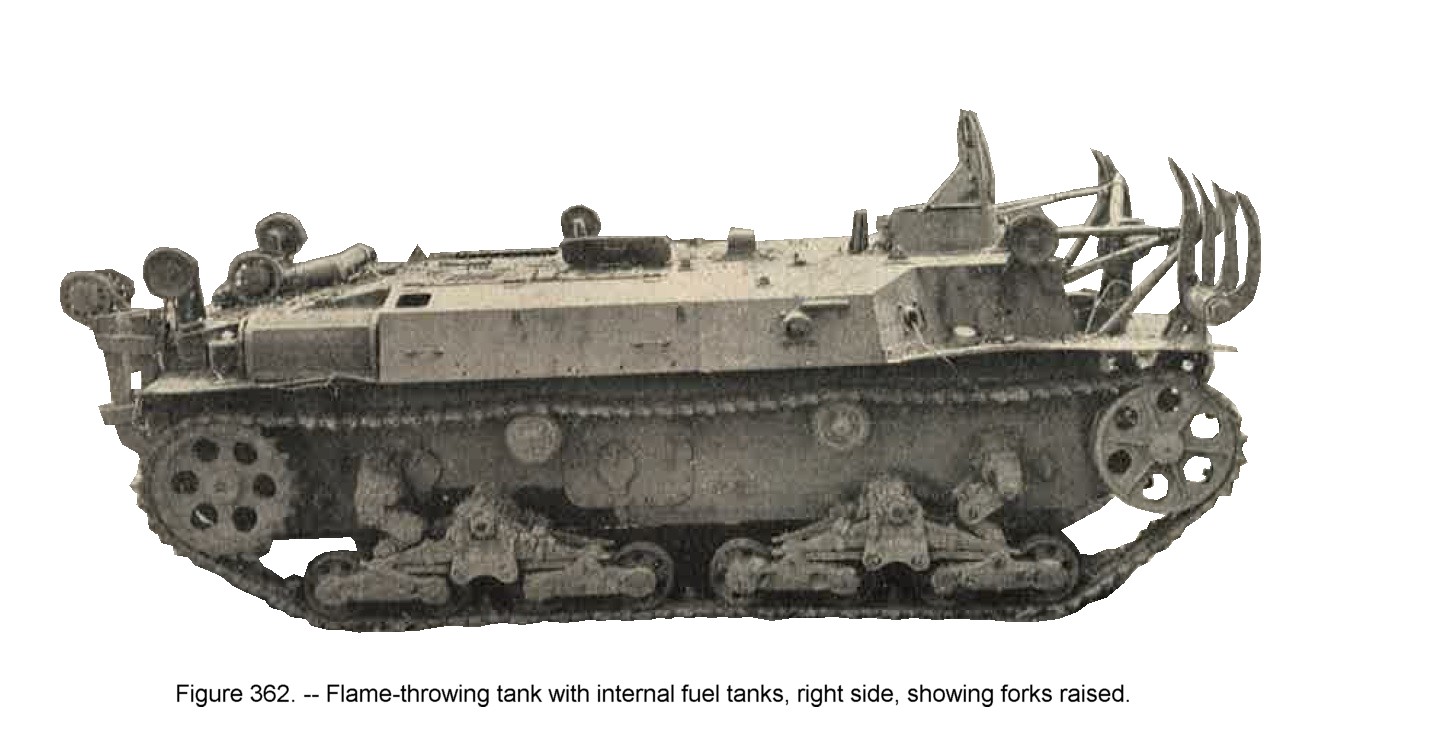 |
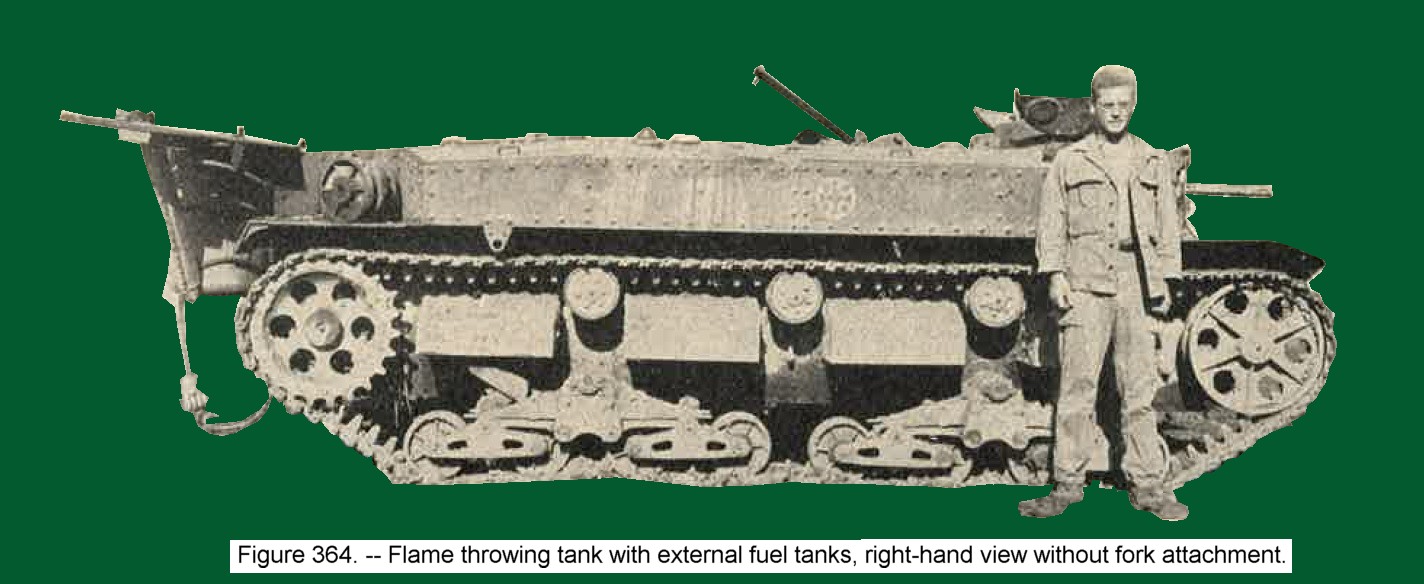 |
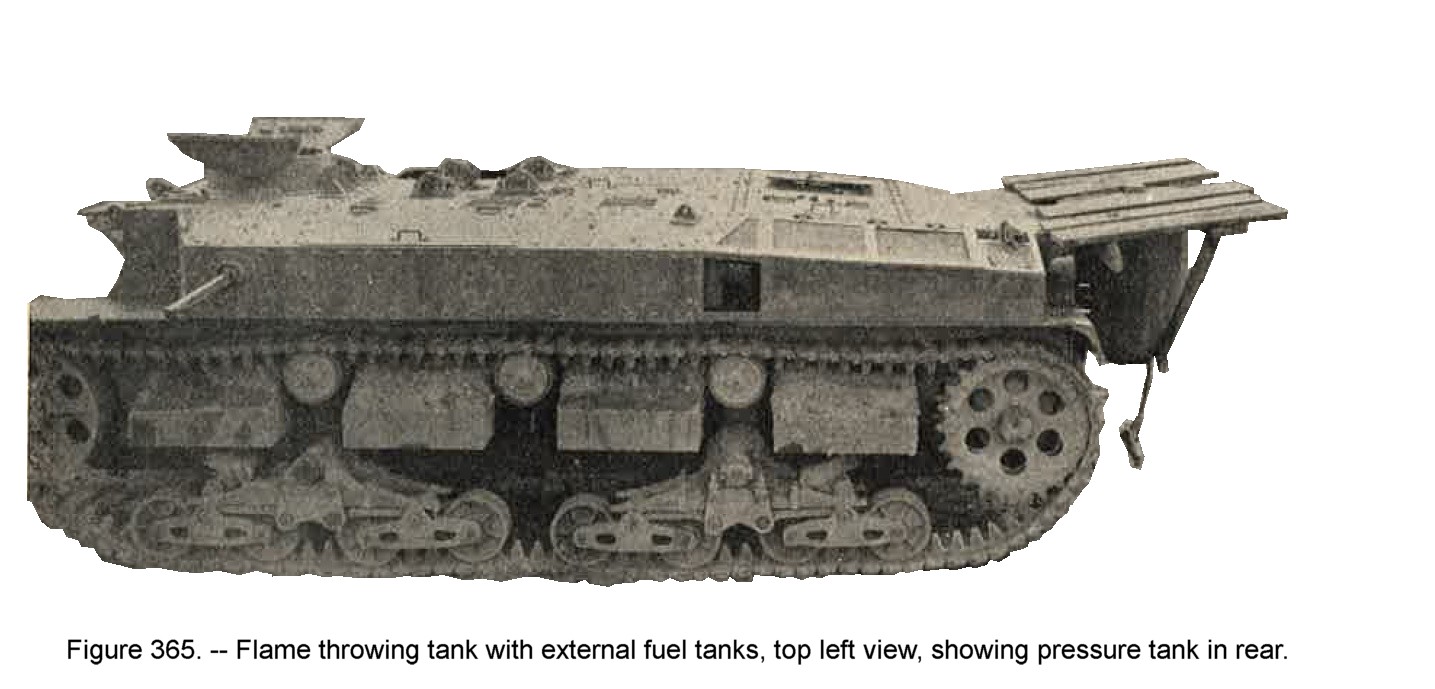 |
b. Japanese Type 96 (1936) SS (super-small) bridge-laying and flame-throwing tanks.
A document refers to the specifications ofthis tank, but not to any features of identiication.
Approximate Specifications:
Approximate maximum performance:
|
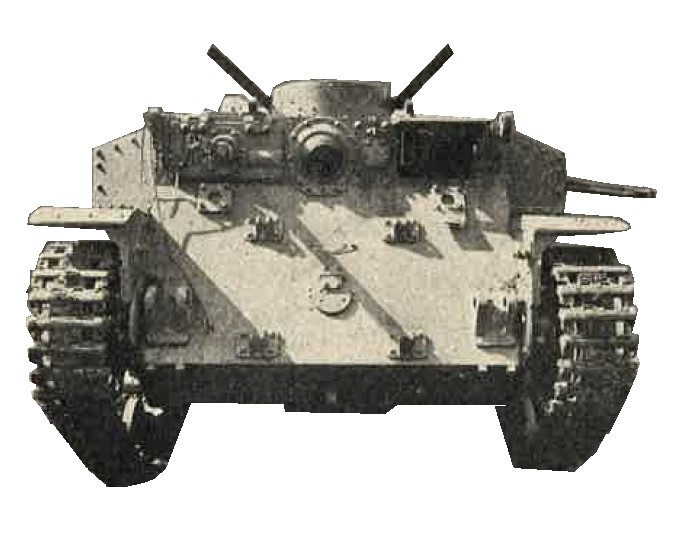
Figure 566. Flame throwing tank with external fuel tanks, front view without fork attachment in place. |

8. WWII JAPANESE TANK GUNS.
The following weapons are known to be used in Japanese tanks and armored cars:
a. Type 91 (1931) 6.5-mm MG.
This gase operated, air cooled, hopper fed weapon is the old Type 11 (1922) 6.5-mm infnatry machine gun modified for tank mounting by the removal of the bipod and the addition of a telescopic sight.
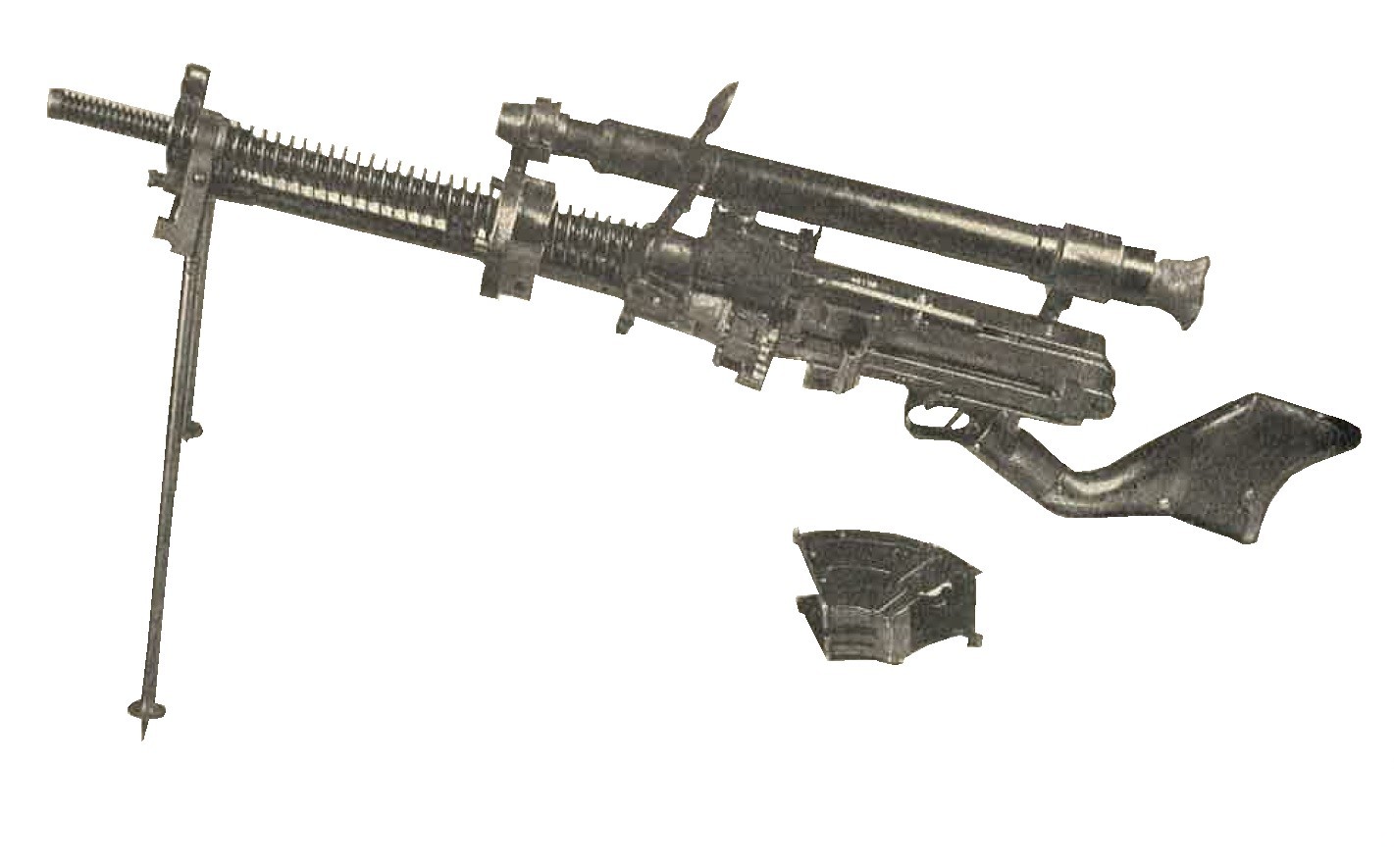
Figure 367. Type 91 (1931) 6.5-mm tank machine gun, showing telescope in place and bipod fitted for use as a ground light machine gun. No iron sights are fitted. Removable hopper is larger than that for Type 11 LMG. |
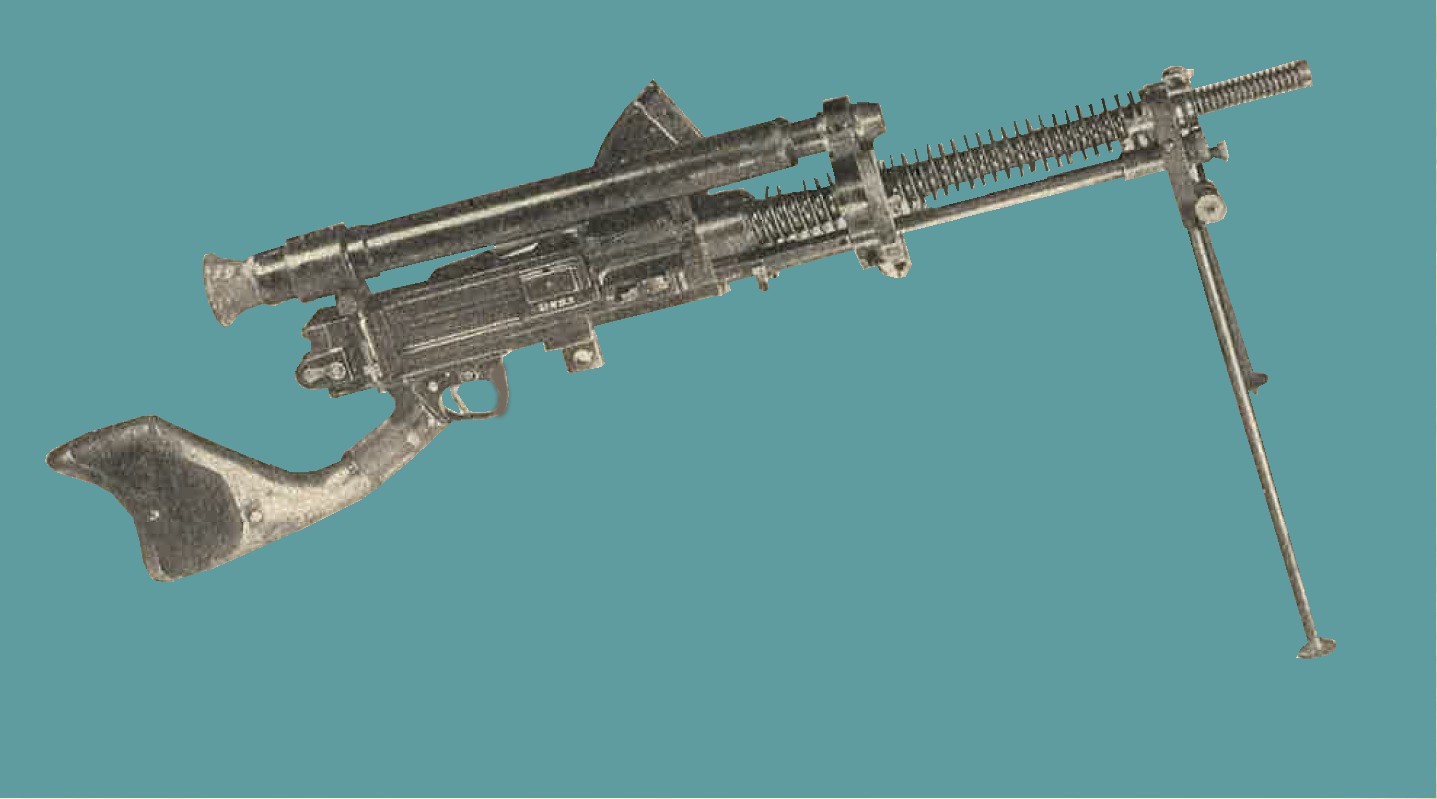
Figure 368. Type 91 (1931) 6.5-mm air cooled tank machine gun, right side, showing mounting for telescopic sight. The gun is fed by placing ordinary 6.5-mm five round rifle ammunition clips in the hopper on the left side of the gun. |
For detailed characteristics of the Type II (1922) 6.5-mm infantry machine gun see Section IV, paragraph b. This tank mounted weapon has not been replaced ny the other Type 97 (1937) 7.7-mm tank machine gun.
b. Japanese Type 97 (1937) 7.7-mm tank Machine Gun.
The Type 97 (1937) 7.7-mm tank machine gun is the standard weapon of the machine gun class in all recent Japanese tanks. A shoulder constrolled weapon, it is fitted with a pistol grip and an adjustable stock. It is gas operated and air cooled. No provision is made for semiautomatic fire.
In addition to the iron sights, a telescopic sight of 1.5 power and 30 degree field of vision is usually fitted. To prevent injury to the gunner, a heavy rubber eye pad is attached to the rear of the telescope. By the addition of the bipod this weapon may be converted to ground use. Recently it has been recovered with muzzle brake and the sights on the right side.
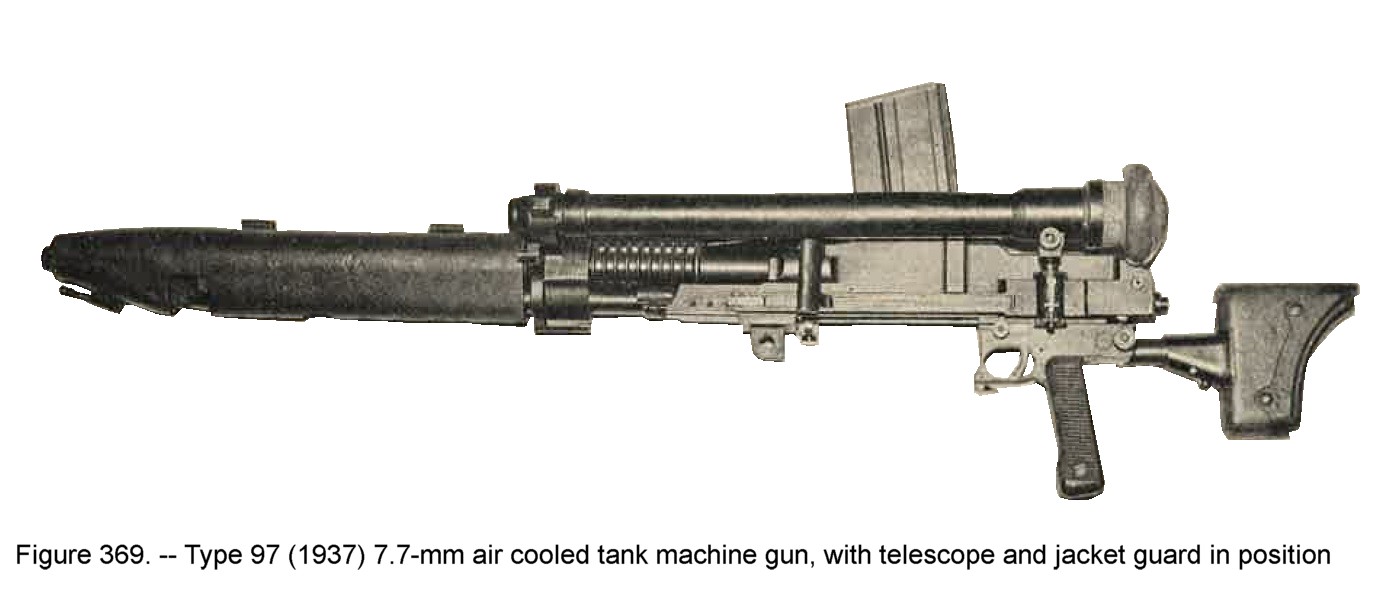
Figure 369. Type 97 (1937) 7.7-mm air cooled tank machine gun, with telescope and jacket guard in position.
CHARACTERISTICS:
| Caliber | ---------- | 7.7-mm (0.303 inch) |
| Weight | ---------- | 25.2 pounds (without magazine, armored barrel jacket, or telescopic sight), |
| Length (with stock fully extended). | ---------- | 47 inches. |
| Barrel length | ---------- | 28 inches. |
| Feed | ---------- | Vertical 30 round box magazine. |
| Sights | ---------- | Blade front sight and aperture back sight. |
| Muzzle velocity | ---------- | 2,375 feet per second. |
| Cyclic rate of fire | ---------- | 500 rounds per minute. |
| Ammunition | ---------- | Rimless; ball, AP, tracer. (Same as fired in Type 99 (1939) 7.7-mm rifle and light machine gun). |
c. Japanese Type 92 (1932) 13.2-mm Machine Gun.
The Japanese refer to this gas operated, air cooled , magazine fed weapon as teh "13.2-mm vehicular machine gun". According to the Japanese, it is designed for use as teh primary armament of armored cars. although no reliable information is available concerning this weapon, it is believed to be of Hotchkiss design and, therefore, probably closely resembles the Type 93 (1933) 13.2-mm machine gun in both perofrmance and general characteristics.
d. Japanese Type 94 (1934) 37-mm tank Gun.
Although bearing the same type number as the antitank gun of similar caliber, these two weapons must not be confused as each was designed for a specific purpose.
|
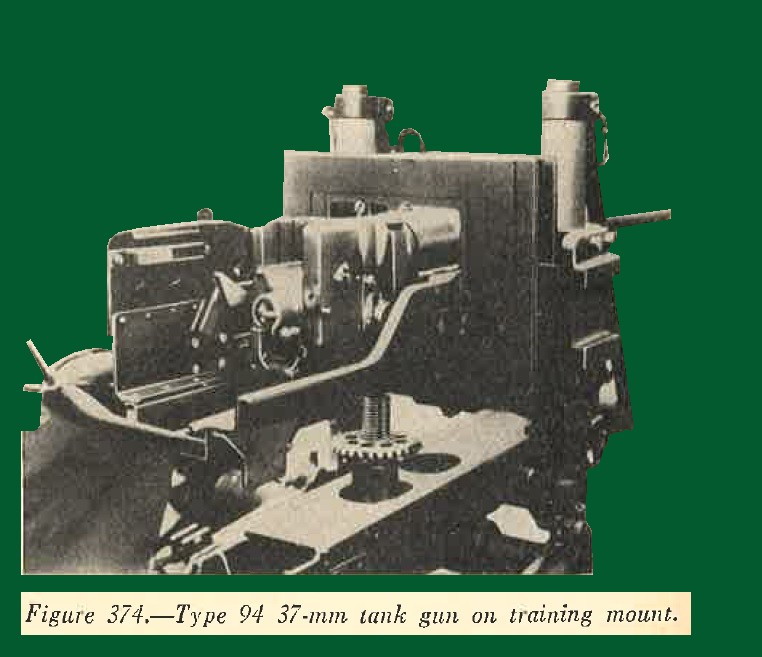 |
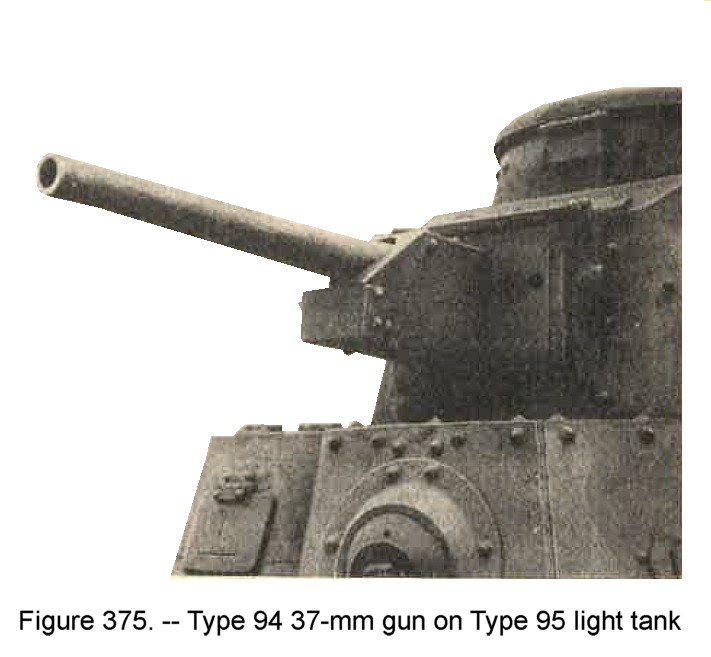 |
Characteristics:
|

e. Japanese Type 98 (1938) 37-mm tank Gun.
This weapon has recently been recovered, but a complete report has not yet been made. The gun was first found mounted in a Nick fighter plane. The first time it was reported as being tank-mounted was on Saipan. Documentary evidence shows this weapon to be superior to the standard Type 94 (1934) 37-mm tank gun.
It has the same chamber dimensionsand the same gun and barrel lengths as teh Type 94, indicating that it is the same gun, rechambered to take a cartridge case 6.53 inches long. The Type 98 tank gun has a muzzle velocity of approximately 2,200 feet per second.
Characteristics:
| 1. | Caliber | --------- | 37-mm (1.46 inches). |
| 2. | Total length of gun | --------- | 53.9 inches. |
| 3. | Barrel Length | --------- | 49.5 inches. |
| 4. | Ammunition | --------- | AP and HE. |
f. Japanese Type 1 (1941) 37-mm tank Gun.
This weapon is known to be the primary armament of the Model 2 (1942) amphibious tank. The weapon recovered was not in good condition to be test fired, nor has any ammunition data been reported. Measurements of the chamber show conclusevily that this weapon uses a cartridge case larger than that used with any other known Japanese 37-mm gun. A higher muzzle velocity than that of the Type 98 (1938) is therefore indicated.
Characteristics:
| 1. | Caliber | --------- | 37-mm (1.46 inches). |
| 2. | Total length of gun | --------- | 67 inches. |
| 3. | Length of rifling | --------- | 52.89 inches. |
| 4. | Length of chamber | --------- | 10.1 inches. |
| 5. | Depth of breech recess | --------- | 4.17 inches. |
g. Japanese Type 1 (1941) 47-mm tank Gun.
|
This tank gun is a modified version of the Type 1 (1941) 47-mm Japanese antitank gun. The sliding wedge breechlock,
however, has been changed from the horizontal to a vertical position. A high velocity gun, it is equipped with a
hydrospring recoil mechanism and a semiautomatic breechlock.
As the gun is mounted at the point of balance, no equilibrators are used. Tests have shown that the gun will penetrate at least 3.25 inches of armor plate at 500 yards, at normal angle of impact. 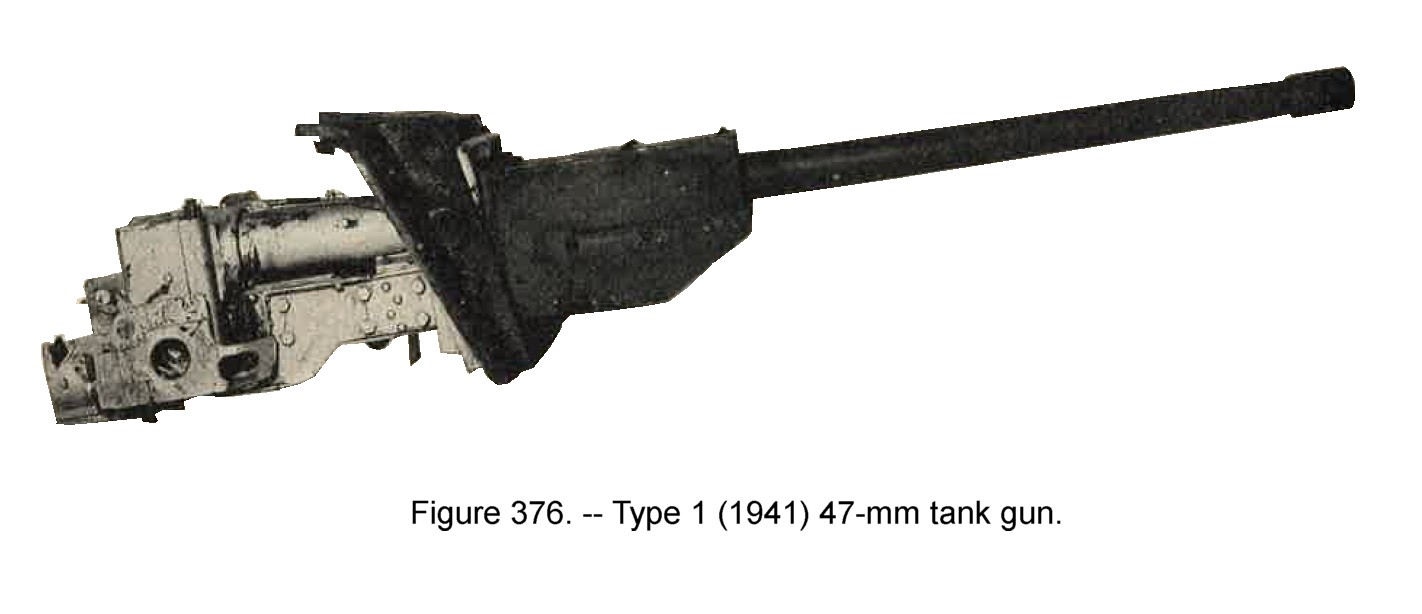
|
Characteristics:
|
h. Japanese Type 90 (1930) 57-mm tank Gun.
The Type 90 (1930) 57-mm tank gun appears to have been the forerunner of the Type 97 (1937) 57-mm tank gun and therefore is probably obsolete. The Type 90 is a short barreled weapon with a low muzzle velocity. It has not been encountered, but the Japanese state that it is the primary armament of the Types 89A and 89B (1929) medium tanks.
The tube is of monobloc construction.
Reported Characteristics:
|
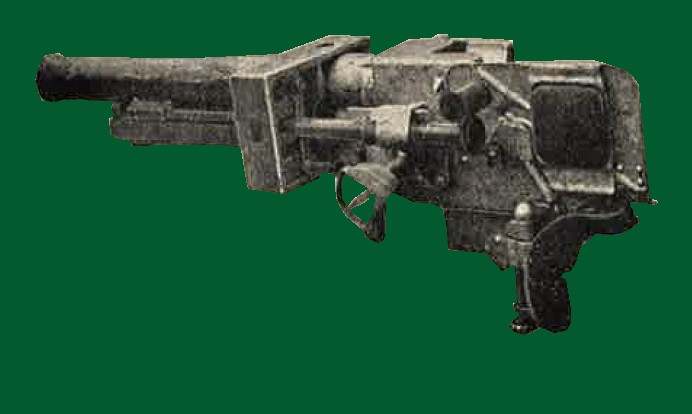
Figure 377. Type 90 (1930) 57-mm gun, left side. |
i. Japanese Type 97 (1937) 57-mm tank Gun.
Although several specimens of this 57-mm gun have been captured, their condition prevented a detailed examination. Sufficient information is available, however, to indicate that this gun is a short barreled, low velocity weapon which is probably used in conjunction with a straight telescopic sight. The breech ring is box shaped, and the breechlock is of the vertical sliding semiautomatic type. Firing is effected by a trigger on the left side of the gun which is protected by a trigger guard and pistol grip.
The cocking lever is actuated by the breech, and the weapon is automatically cocked when the breech is opened.
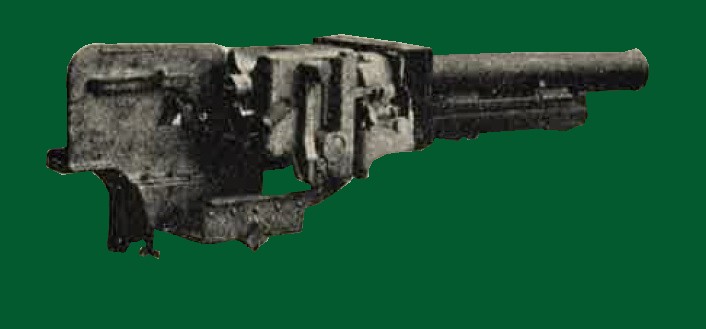
Figure 378. Type 90 (1930) 57-mm gun, right side. |
Characteristics:
|
j. Japanese Type 94 (1934) 70-mm tank Gun.
Characteristics:
|
This weapon, although reported in documents, as yet has not been recovered. The gun uses the same cartridge case as the 70-mm Type 92 infantry gun. |
k. Japanese Type 99 (1939) 75-mm tank Gun (experimental).
Little is known of this weapon. It is referred to in documents, however, as the new 75-mm gun which will be the primary argument in new Japanese medium tanks. It is probable that this weapon will have a performance considerably superior to any Japanese 75-mm gun encountered to date.
l. Japanese Type 38 (1905) 15-cm howitzer.
|
This howitzer was found mounted on the Type 97 (1937) improved medium tank chassis. Type 38 (1905) 15-cm howitzer
is a very short weapon and, until its appearance in this role, had been considered as an obsolete field piece.
It has an interrupted screw breechlock, opening to the right. According to documents, the rifling is 58 inches long and has increasing right hand twist. The maximum range is given as approximately 6,500 yards for the field piece. However, as the self propelled howitzer cannot be elevated above 30 degrees, it is probable that its range in this role is appreciably less than 6,500 yards. |
Characteristics:
|
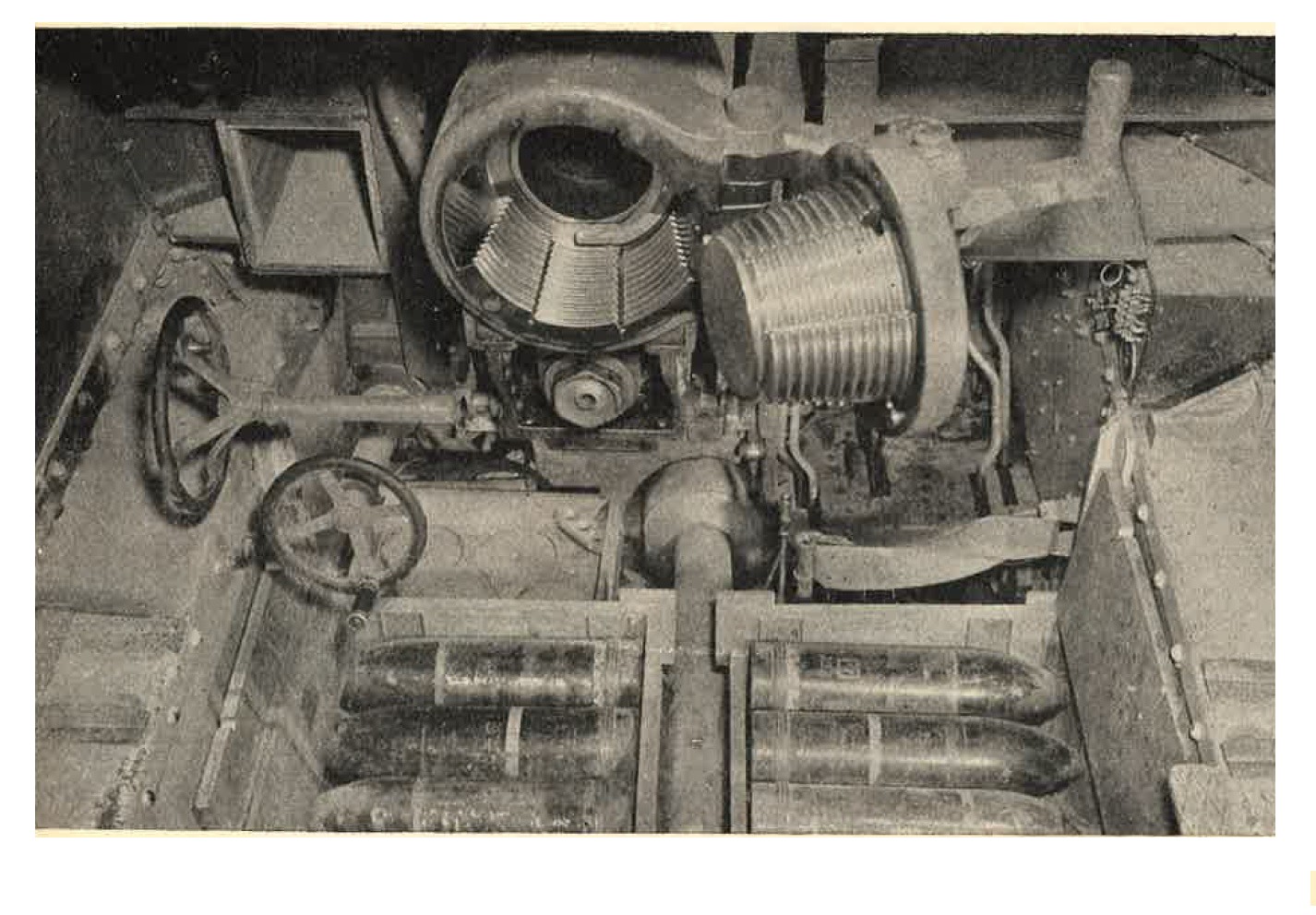
Figure 382. Type 38 (1905) 150-mm howitzer as mounted on the Type 97 (1937) medium tank chassis.
